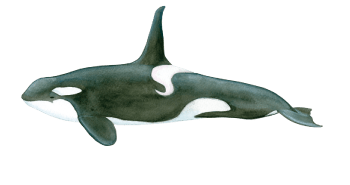
Orca
(Orcinus orca)
Orcas are the largest species of the dolphin family. It is a cosmopolitan species and typically exists in extended pods or family groups. They are cetaceans with a distinct culture, with their language containing actual dialects that vary according to their family and region.
The world population of Orcas seems to consist of specialized subpopulations which are adapted to live off the food resources available in their specific home range. As top marine predators, Orcas are intelligent, highly adaptive and are famous for their complex and coordinated hunting tactics.
They are among the best documented cetaceans, with a lot of data coming from researchers studying populations in the northwest. In this region, several ecotypes were identified that differ greatly in their preferred prey including coastal fish-eaters (“residents”), marine mammal eaters (“transients”) and “offshores”, whose diet is unclear.
Other Orca populations migrate between Alaska and California, depending on the abundance of their prey.
There has never been a documented attack on a human in the wild, on the contrary; there are even stories of orcas actually protecting humans at sea from sharks.
General information
Further names: Portuguese: Orca; English: Killer whale
Size of adults: Male: 7-9,8 m; Female: 4,5-8,5 m
Life span: up to 90 years
Prey: Varies according to pod, region and site fidelity. Variable diet that may include small schooling fish, larger fish, cephalopods, sea turtles, sharks, rays, pinnipeds and other cetaceans including larger baleen whales.
Behaviour: The foundation of most Orca societies is matrilineal in nature, with a female animal leading the pod and passing down its culture to younger generations. Fast swimmers reaching velocities of up to 54 km/h, very surface-active often breaching, spyhopping and tail-slapping. Curious and tolerant of boat approaches allowing the observation of several hunting techniques.
Range: Worldwide; most abundant in cold, temperate coastal areas. Different ecotypes have been identified amongst populations of different regions: “resident” (close to shore and local groups) “transient” (passing by) and “offshore” (further away from coast) types. Despite their cosmopolitan distribution, they are most abundant in cold, temperate and coastal areas.
Distinctive features: Distinctive black and white color pattern that varies according to region and clan. Tall, sword-shaped dorsal fin, more prominent in adult males (up to 2 m), large, rounded flippers and robust bodies.
Madeira: Very rarely encountered. Sightings usually involve transient or offshore groups.
Taxonomy: Taxonomy: Suborder: Odontoceti (Toothed whales), Family: Delphinidae (Dolphins)
New scientific data suggests that there are several species of Orca so it is likely that Orcinus orca will be split into a number of different species or subspecies in the next few years.
Threats: As a species, Orcas are not listed as endangered but whaling and live-capture operations have depleted some regional populations (Northeast Pacific). Some populations are classified as “endangered”. Populations off the coast of British Colombia and Washington are threatened by pollution, heavy ship traffic and possibly by reduced prey abundance.
Population: The worldwide population is unknown, with estimates counting around 50 000 animals. A regularly encountered population of only 32 individuals in the Strait of Gibraltar, each one known and identified by researchers, is now listed as Critically Endangered by the IUCN.
